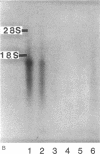Abstract
Plasma prorenin levels are elevated in normal pregnant women. Current evidence suggests renin production by tissues of the uteroplacental unit contribute to this elevation. The purpose of this investigation was to define the source of renin biosynthesis within the human uteroplacental unit and to characterize the renin produced. RNA extraction and Northern blot analysis consistently demonstrated renin mRNA expression in uterine lining both in the pregnant (decidua) and nonpregnant states (endometrium) and in fetal chorion laeve, which is inseparable from the decidua. In contrast, renin mRNA expression was not detected in basal plate and intertwin chorion (which is separate from decidua), amnion, myometrium, or placental villi. The total renin content in decidual homogenates was two- to threefold greater than in endometrial homogenates, and cultured human decidual cells produced significantly more total renin than cultured human endometrial cells, suggesting that pregnancy enhanced renin production by the cells lining the uterus. Immunoblot analysis and [3H]leucine incorporation identified 47,000-mol wt prorenin as the major form of renin produced by cultured human decidual cells. These studies indicate that maternal decidua is the major source of prorenin in the uteroplacental unit.
Full text
PDF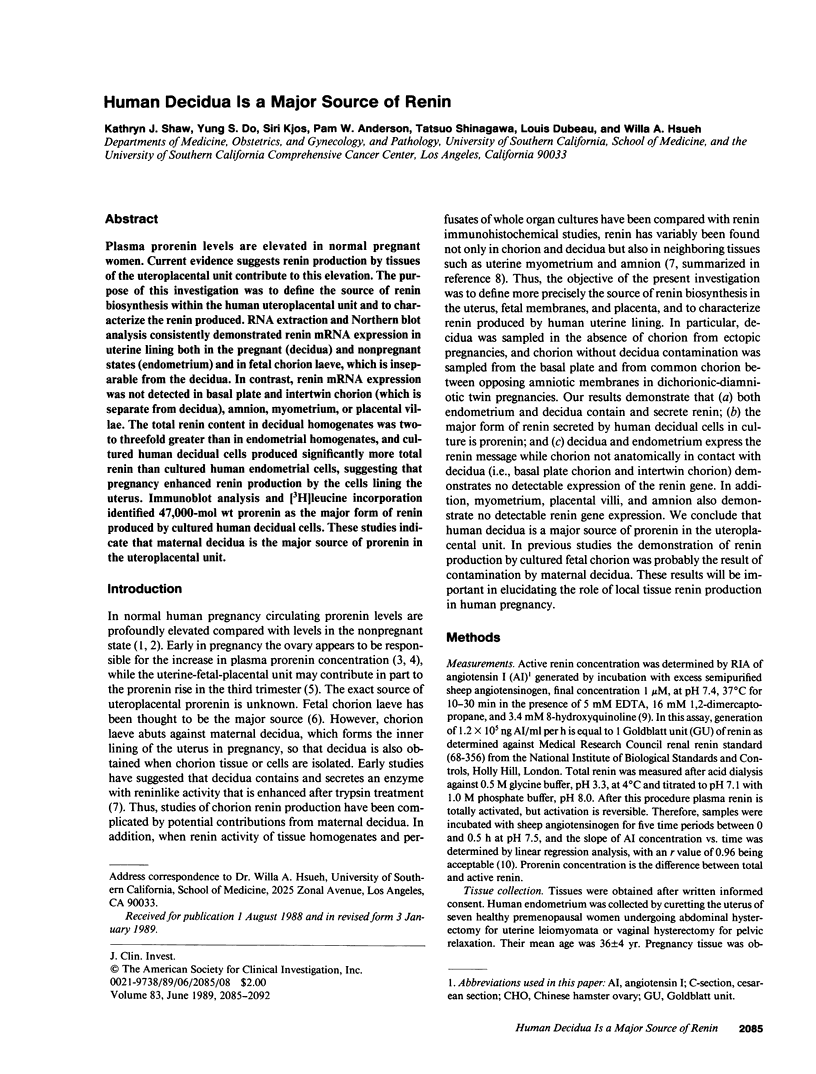
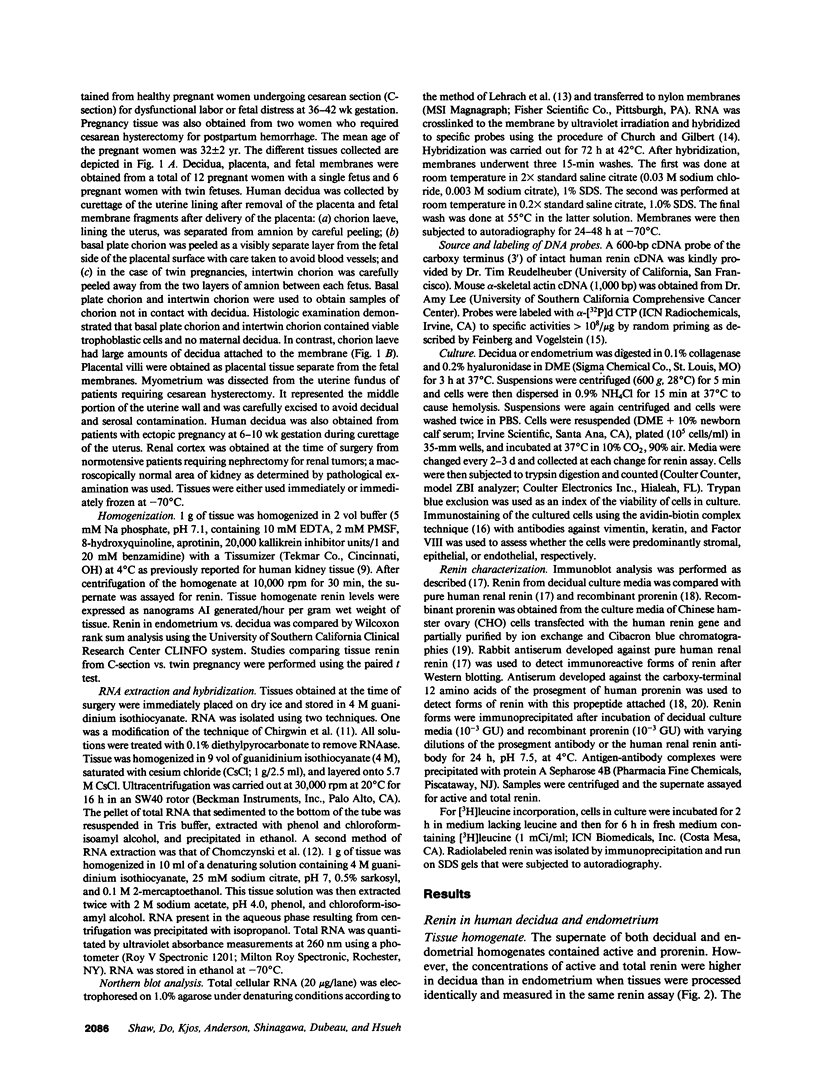
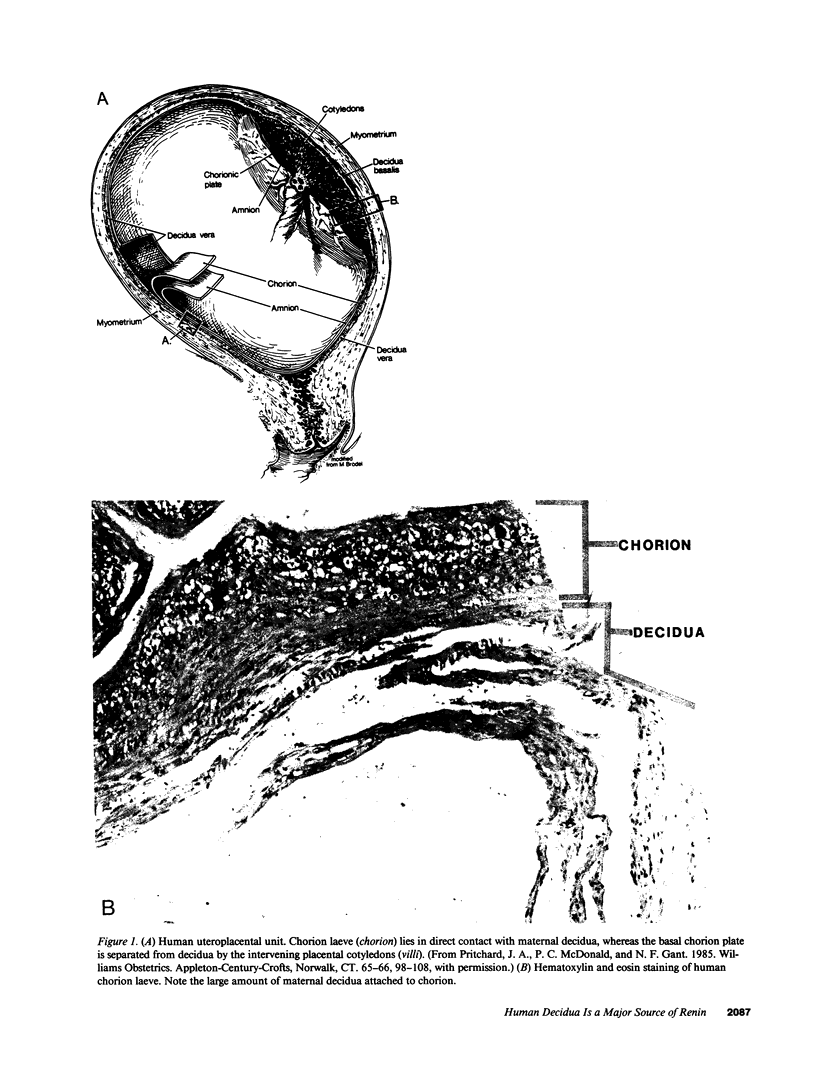
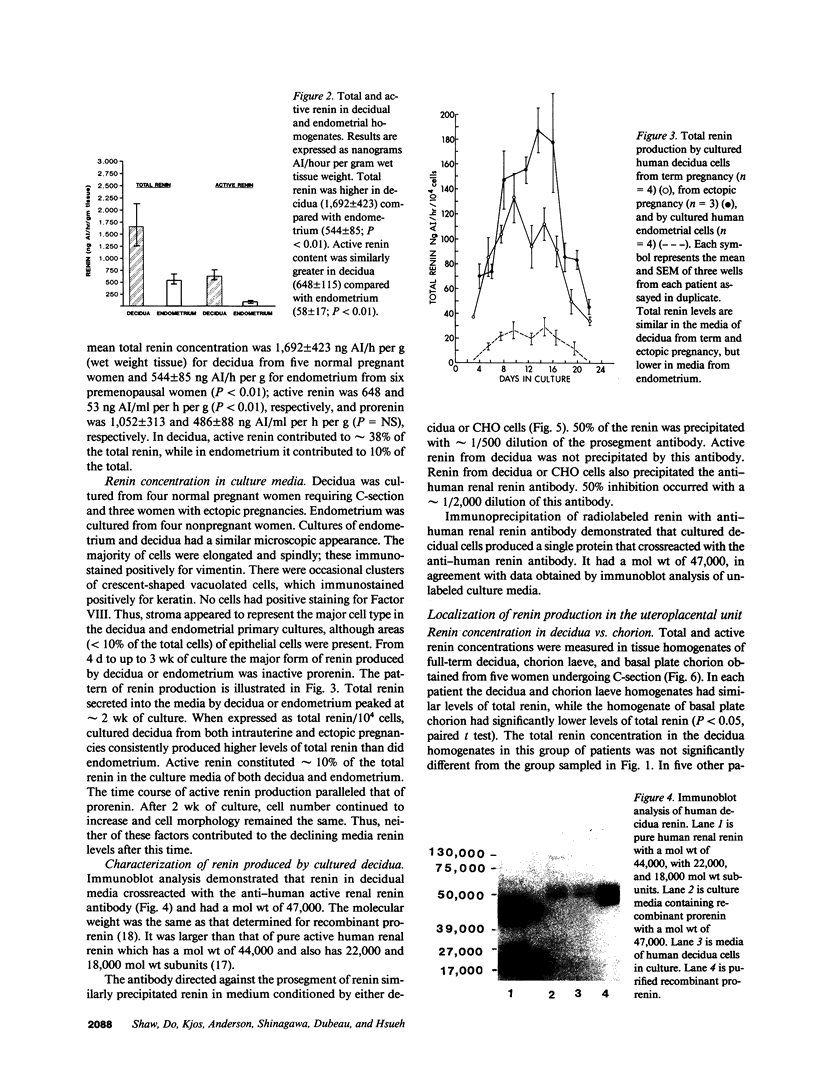
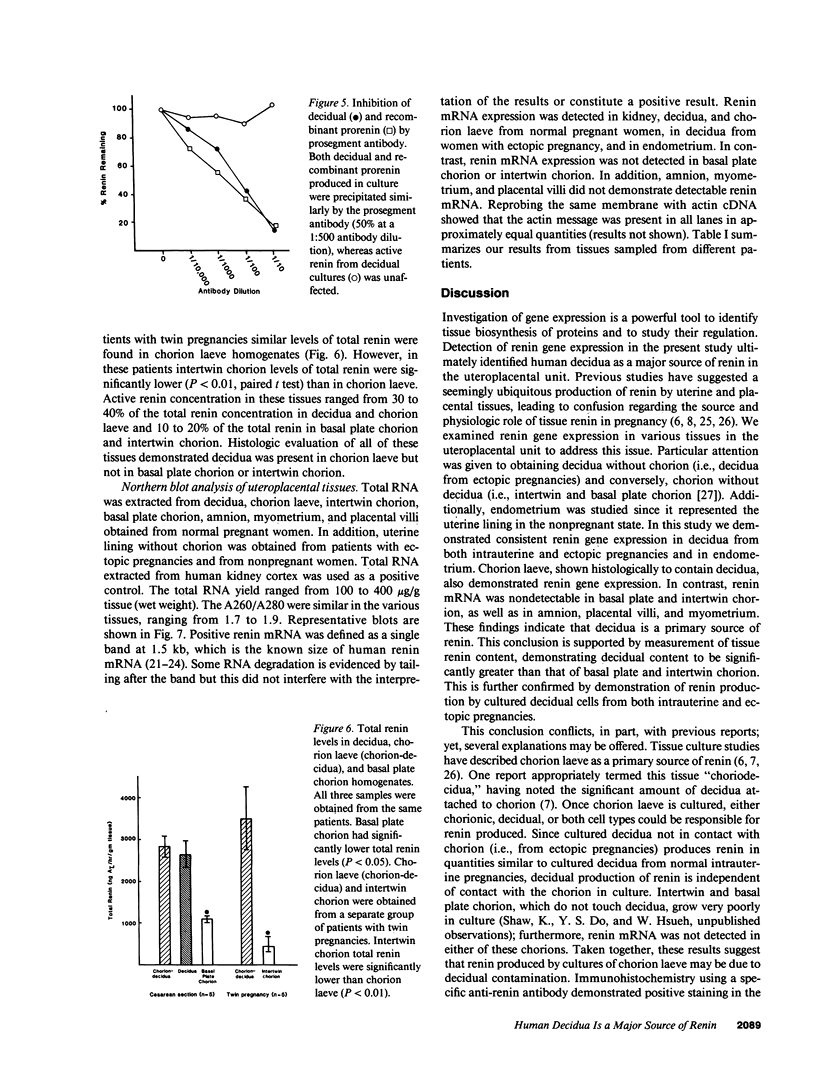
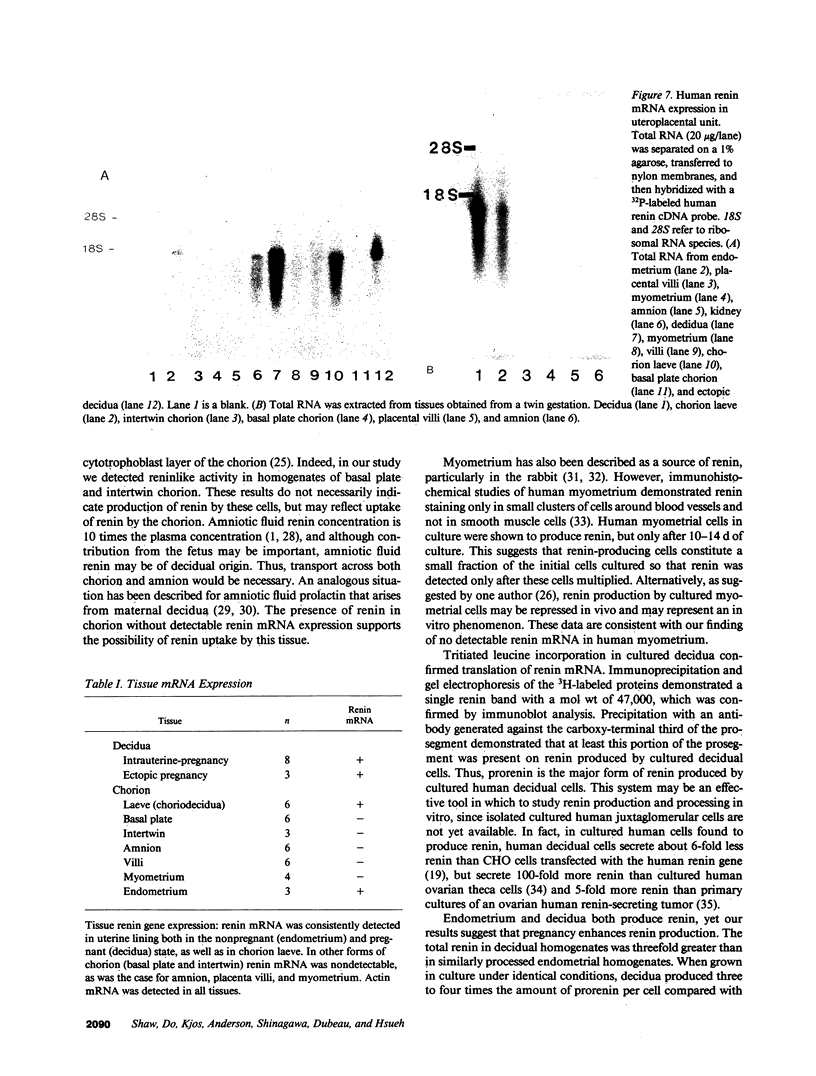
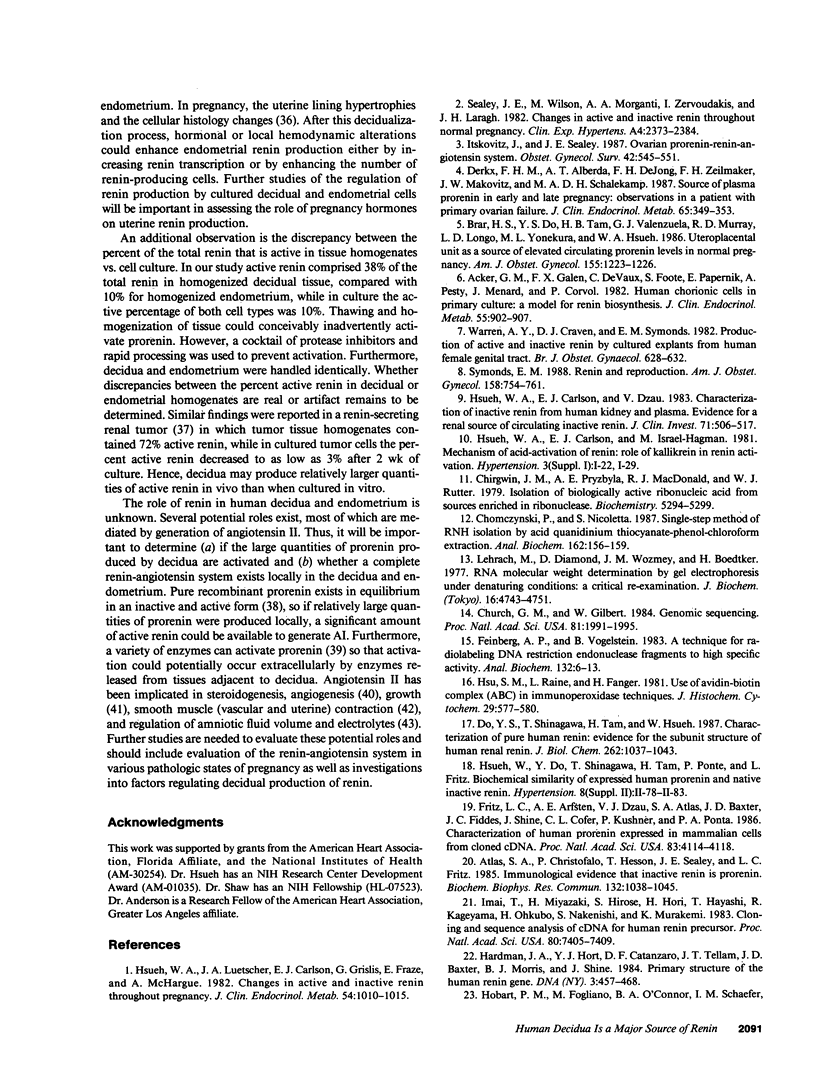
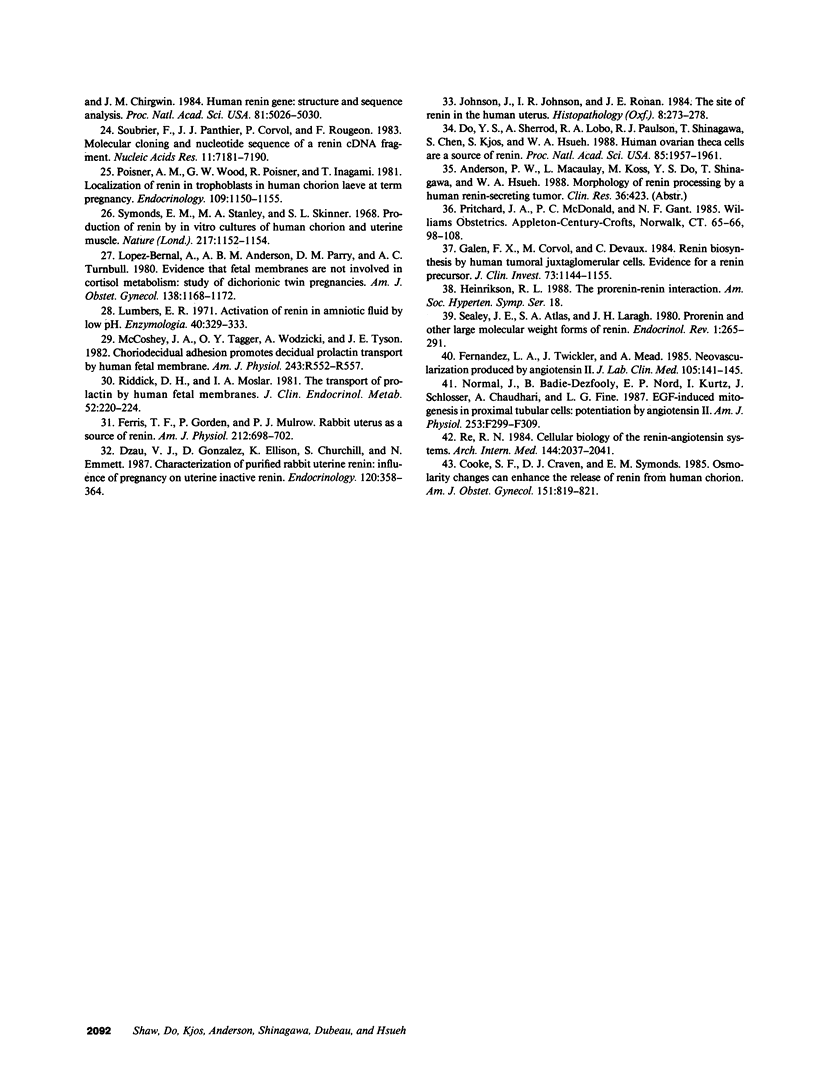
Images in this article
Selected References
These references are in PubMed. This may not be the complete list of references from this article.
- Acker G. M., Galen F. X., Devaux C., Foote S., Papernik E., Pesty A., Menard J., Corvol P. Human chorionic cells in primary culture: a model for renin biosynthesis. J Clin Endocrinol Metab. 1982 Nov;55(5):902–909. doi: 10.1210/jcem-55-5-902. [DOI] [PubMed] [Google Scholar]
- Atlas S. A., Christofalo P., Hesson T., Sealey J. E., Fritz L. C. Immunological evidence that inactive renin is prorenin. Biochem Biophys Res Commun. 1985 Nov 15;132(3):1038–1045. doi: 10.1016/0006-291x(85)91911-4. [DOI] [PubMed] [Google Scholar]
- Brar H. S., Do Y. S., Tam H. B., Valenzuela G. J., Murray R. D., Longo L. D., Yonekura M. L., Hsueh W. A. Uteroplacental unit as a source of elevated circulating prorenin levels in normal pregnancy. Am J Obstet Gynecol. 1986 Dec;155(6):1223–1226. doi: 10.1016/0002-9378(86)90148-1. [DOI] [PubMed] [Google Scholar]
- Chirgwin J. M., Przybyla A. E., MacDonald R. J., Rutter W. J. Isolation of biologically active ribonucleic acid from sources enriched in ribonuclease. Biochemistry. 1979 Nov 27;18(24):5294–5299. doi: 10.1021/bi00591a005. [DOI] [PubMed] [Google Scholar]
- Chomczynski P., Sacchi N. Single-step method of RNA isolation by acid guanidinium thiocyanate-phenol-chloroform extraction. Anal Biochem. 1987 Apr;162(1):156–159. doi: 10.1006/abio.1987.9999. [DOI] [PubMed] [Google Scholar]
- Church G. M., Gilbert W. Genomic sequencing. Proc Natl Acad Sci U S A. 1984 Apr;81(7):1991–1995. doi: 10.1073/pnas.81.7.1991. [DOI] [PMC free article] [PubMed] [Google Scholar]
- Cooke S. F., Craven D. J., Symonds E. M. Osmolarity changes can enhance the release of renin from human chorion. Am J Obstet Gynecol. 1985 Mar 15;151(6):819–821. doi: 10.1016/0002-9378(85)90528-9. [DOI] [PubMed] [Google Scholar]
- Derkx F. H., Alberda A. T., de Jong F. H., Zeilmaker F. H., Makovitz J. W., Schalekamp M. A. Source of plasma prorenin in early and late pregnancy: observations in a patient with primary ovarian failure. J Clin Endocrinol Metab. 1987 Aug;65(2):349–354. doi: 10.1210/jcem-65-2-349. [DOI] [PubMed] [Google Scholar]
- Do Y. S., Sherrod A., Lobo R. A., Paulson R. J., Shinagawa T., Chen S. W., Kjos S., Hsueh W. A. Human ovarian theca cells are a source of renin. Proc Natl Acad Sci U S A. 1988 Mar;85(6):1957–1961. doi: 10.1073/pnas.85.6.1957. [DOI] [PMC free article] [PubMed] [Google Scholar]
- Do Y. S., Shinagawa T., Tam H., Inagami T., Hsueh W. A. Characterization of pure human renal renin. Evidence for a subunit structure. J Biol Chem. 1987 Jan 25;262(3):1037–1043. [PubMed] [Google Scholar]
- Dzau V. J., Gonzalez D., Ellison K., Churchill S., Emmett N. Characterization of purified rabbit uterine renin: influence of pregnancy on uterine inactive renin. Endocrinology. 1987 Jan;120(1):358–364. doi: 10.1210/endo-120-1-358. [DOI] [PubMed] [Google Scholar]
- Feinberg A. P., Vogelstein B. A technique for radiolabeling DNA restriction endonuclease fragments to high specific activity. Anal Biochem. 1983 Jul 1;132(1):6–13. doi: 10.1016/0003-2697(83)90418-9. [DOI] [PubMed] [Google Scholar]
- Fernandez L. A., Twickler J., Mead A. Neovascularization produced by angiotensin II. J Lab Clin Med. 1985 Feb;105(2):141–145. [PubMed] [Google Scholar]
- Fritz L. C., Arfsten A. E., Dzau V. J., Atlas S. A., Baxter J. D., Fiddes J. C., Shine J., Cofer C. L., Kushner P., Ponte P. A. Characterization of human prorenin expressed in mammalian cells from cloned cDNA. Proc Natl Acad Sci U S A. 1986 Jun;83(12):4114–4118. doi: 10.1073/pnas.83.12.4114. [DOI] [PMC free article] [PubMed] [Google Scholar]
- Galen F. X., Devaux C., Houot A. M., Menard J., Corvol P., Corvol M. T., Gubler M. C., Mounier F., Camilleri J. P. Renin biosynthesis by human tumoral juxtaglomerular cells. Evidences for a renin precursor. J Clin Invest. 1984 Apr;73(4):1144–1155. doi: 10.1172/JCI111300. [DOI] [PMC free article] [PubMed] [Google Scholar]
- Hardman J. A., Hort Y. J., Catanzaro D. F., Tellam J. T., Baxter J. D., Morris B. J., Shine J. Primary structure of the human renin gene. DNA. 1984 Dec;3(6):457–468. doi: 10.1089/dna.1.1984.3.457. [DOI] [PubMed] [Google Scholar]
- Hobart P. M., Fogliano M., O'Connor B. A., Schaefer I. M., Chirgwin J. M. Human renin gene: structure and sequence analysis. Proc Natl Acad Sci U S A. 1984 Aug;81(16):5026–5030. doi: 10.1073/pnas.81.16.5026. [DOI] [PMC free article] [PubMed] [Google Scholar]
- Hsu S. M., Raine L., Fanger H. Use of avidin-biotin-peroxidase complex (ABC) in immunoperoxidase techniques: a comparison between ABC and unlabeled antibody (PAP) procedures. J Histochem Cytochem. 1981 Apr;29(4):577–580. doi: 10.1177/29.4.6166661. [DOI] [PubMed] [Google Scholar]
- Hsueh W. A., Carlson E. J., Dzau V. J. Characterization of inactive renin from human kidney and plasma. Evidence of a renal source of circulating inactive renin. J Clin Invest. 1983 Mar;71(3):506–517. doi: 10.1172/JCI110795. [DOI] [PMC free article] [PubMed] [Google Scholar]
- Hsueh W. A., Luetscher J. A., Carlson E. J., Grislis G., Fraze E., McHargue A. Changes in active and inactive renin throughout pregnancy. J Clin Endocrinol Metab. 1982 May;54(5):1010–1016. doi: 10.1210/jcem-54-5-1010. [DOI] [PubMed] [Google Scholar]
- Imai T., Miyazaki H., Hirose S., Hori H., Hayashi T., Kageyama R., Ohkubo H., Nakanishi S., Murakami K. Cloning and sequence analysis of cDNA for human renin precursor. Proc Natl Acad Sci U S A. 1983 Dec;80(24):7405–7409. doi: 10.1073/pnas.80.24.7405. [DOI] [PMC free article] [PubMed] [Google Scholar]
- Itskovitz J., Sealey J. E. Ovarian prorenin-renin-angiotensin system. Obstet Gynecol Surv. 1987 Sep;42(9):545–551. doi: 10.1097/00006254-198709000-00003. [DOI] [PubMed] [Google Scholar]
- Johnson J., Johnson I. R., Ronan J. E., Craven D. J. The site of renin in the human uterus. Histopathology. 1984 Mar;8(2):273–278. doi: 10.1111/j.1365-2559.1984.tb02341.x. [DOI] [PubMed] [Google Scholar]
- Lehrach H., Diamond D., Wozney J. M., Boedtker H. RNA molecular weight determinations by gel electrophoresis under denaturing conditions, a critical reexamination. Biochemistry. 1977 Oct 18;16(21):4743–4751. doi: 10.1021/bi00640a033. [DOI] [PubMed] [Google Scholar]
- Lumbers E. R. Activation of renin in human amniotic fluid by low pH. Enzymologia. 1971 Jun 30;40(6):329–336. [PubMed] [Google Scholar]
- López Bernal A., Anderson A. B., Parry D. M., Turnbull A. C. Evidence that fetal membranes are not involved in cortisol metabolism: study of dichorionic twin pregnancies. Am J Obstet Gynecol. 1980 Dec 15;138(8):1168–1172. doi: 10.1016/s0002-9378(16)32786-7. [DOI] [PubMed] [Google Scholar]
- McCoshen J. A., Tagger O. Y., Wodzicki A., Tyson J. E. Choriodecidual adhesion promotes decidual prolactin transport by human fetal membrane. Am J Physiol. 1982 Nov;243(5):R552–R557. doi: 10.1152/ajpregu.1982.243.5.R552. [DOI] [PubMed] [Google Scholar]
- Norman J., Badie-Dezfooly B., Nord E. P., Kurtz I., Schlosser J., Chaudhari A., Fine L. G. EGF-induced mitogenesis in proximal tubular cells: potentiation by angiotensin II. Am J Physiol. 1987 Aug;253(2 Pt 2):F299–F309. doi: 10.1152/ajprenal.1987.253.2.F299. [DOI] [PubMed] [Google Scholar]
- Poisner A. M., Wood G. W., Poisner R., Inagami T. Localization of renin in trophoblasts in human chorion laeve at term pregnancy. Endocrinology. 1981 Oct;109(4):1150–1155. doi: 10.1210/endo-109-4-1150. [DOI] [PubMed] [Google Scholar]
- Re R. N. Cellular biology of the renin-angiotensin systems. Arch Intern Med. 1984 Oct;144(10):2037–2041. [PubMed] [Google Scholar]
- Riddick D. H., Maslar I. A. The transport of prolactin by human fetal membranes. J Clin Endocrinol Metab. 1981 Feb;52(2):220–224. doi: 10.1210/jcem-52-2-220. [DOI] [PubMed] [Google Scholar]
- Sealey J. E., Wilson M., Morganti A. A., Zervoudakis I., Laragh J. H. Changes in active and inactive renin throughout normal pregnancy. Clin Exp Hypertens A. 1982;4(11-12):2373–2384. doi: 10.3109/10641968209062396. [DOI] [PubMed] [Google Scholar]
- Soubrier F., Panthier J. J., Corvol P., Rougeon F. Molecular cloning and nucleotide sequence of a human renin cDNA fragment. Nucleic Acids Res. 1983 Oct 25;11(20):7181–7190. doi: 10.1093/nar/11.20.7181. [DOI] [PMC free article] [PubMed] [Google Scholar]
- Symonds E. M. Renin and reproduction. Am J Obstet Gynecol. 1988 Apr;158(4):754–761. doi: 10.1016/0002-9378(88)90068-3. [DOI] [PubMed] [Google Scholar]
- Symonds E. M., Stanley M. A., Skinner S. L. Production of renin by in vitro cultures of human chorion and uterine muscle. Nature. 1968 Mar 23;217(5134):1152–1153. doi: 10.1038/2171152a0. [DOI] [PubMed] [Google Scholar]
- Warren A. Y., Craven D. J., Symonds E. M. Production of active and inactive renin by cultured explants from the human female genital tract. Br J Obstet Gynaecol. 1982 Aug;89(8):628–632. doi: 10.1111/j.1471-0528.1982.tb04717.x. [DOI] [PubMed] [Google Scholar]





